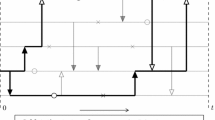Abstract.
Deterministic models of mutation and selection in the space of (binary) nucleotide-type sequences have been investigated for haploid populations during the past 25 years, and, recently, for diploid populations as well. These models, in particular their ‘error thresholds’, have mainly been analyzed by numerical methods and perturbation techniques. We consider them here by means of bifurcation theory, which improves our understanding of both equilibrium and dynamical properties.
In a caricature obtained from the original model by neglecting back mutation to the favourable allele, the familiar error threshold of the haploid two-class model turns out to be a simple transcritical bifurcation, whereas its diploid counterpart exhibits an additional saddle node. This corresponds to a second error threshold. Three-class models with neutral spaces of unequal size introduce further features. Such are a global bifurcation in haploid populations, and simple examples of Hopf bifurcations (as predicted by Akin’s theorem) in the diploid case.
Similar content being viewed by others
Author information
Authors and Affiliations
Additional information
Received 13 June 1995; received in revised form 26 July 1996
Rights and permissions
About this article
Cite this article
Baake, E., Wiehe, T. Bifurcations in haploid and diploid sequence space models. J Math Biol 35, 321–343 (1997). https://doi.org/10.1007/s002850050054
Issue Date:
DOI: https://doi.org/10.1007/s002850050054




